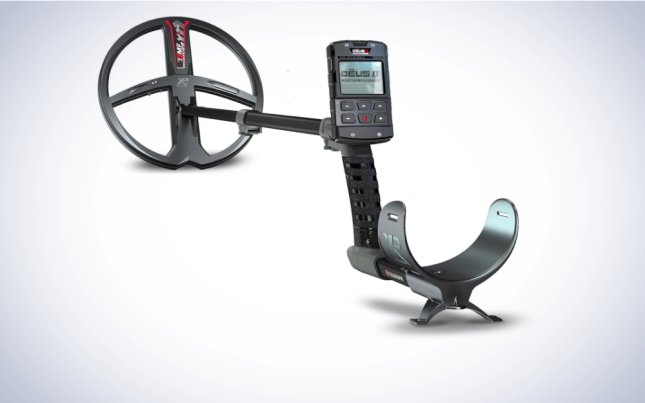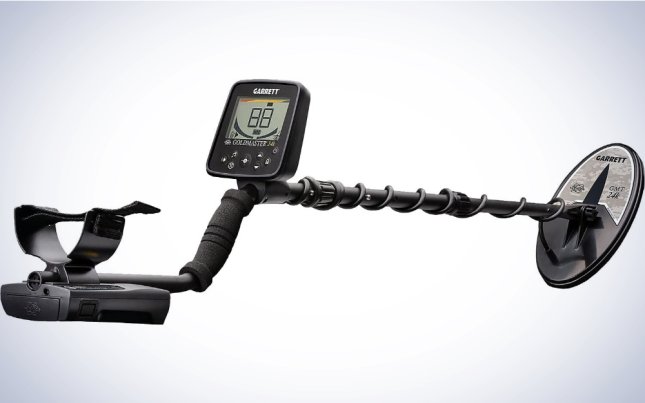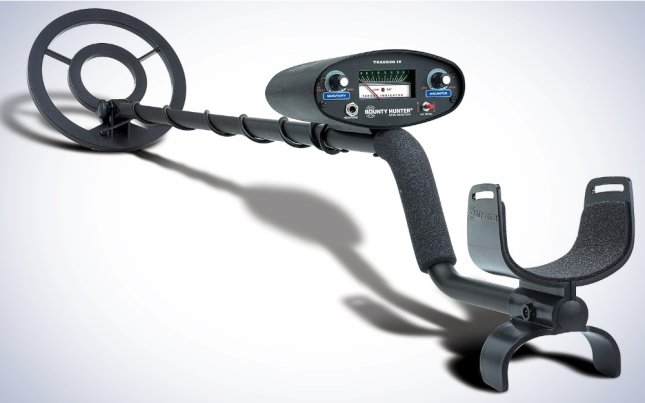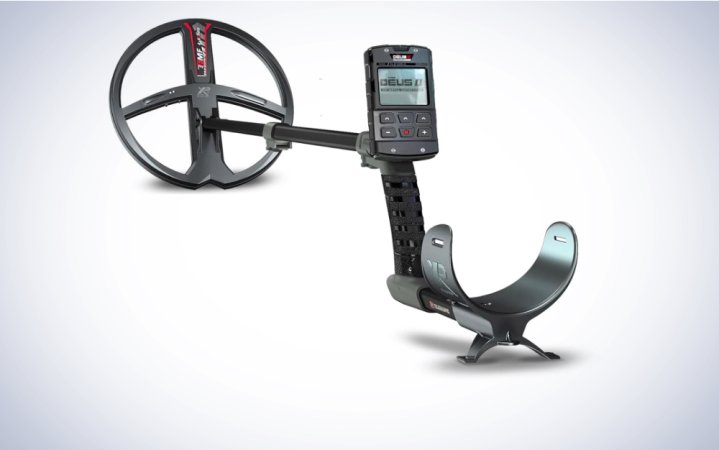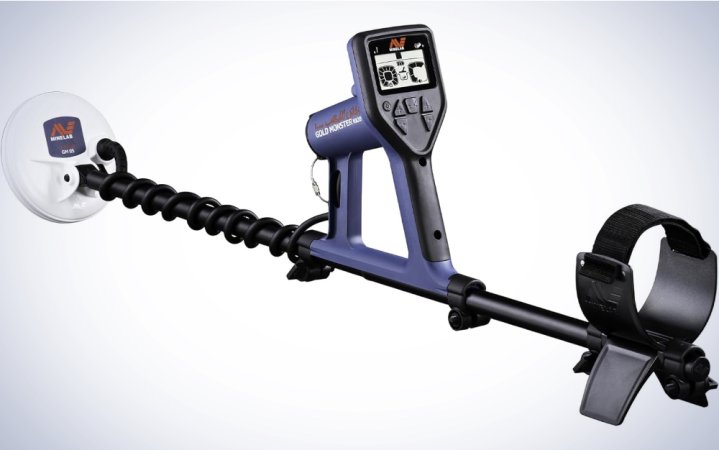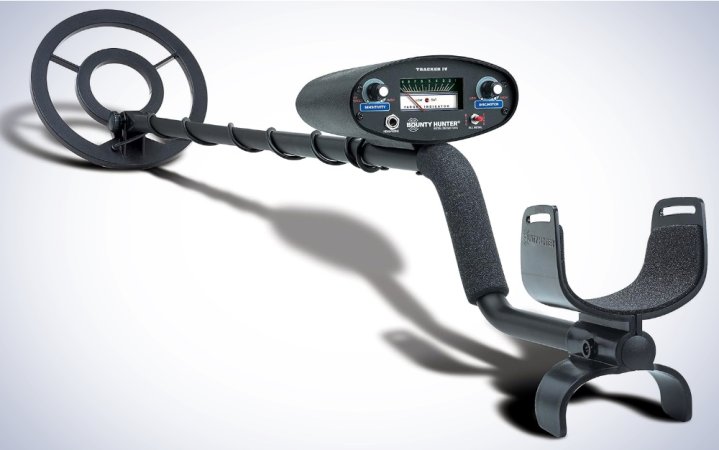We may earn revenue from the products available on this page and participate in affiliate programs. Learn more ›
If you’re hoping to head out and find even a bit of treasure, then a metal detector for gold can make a huge difference. The best detectors are sensitive enough to distinguish between gold and ferrous metals, are often fully submersible, and can even find gold in difficult soils, such as mineralized black sand. Some detectors also come with special features, such as a gold-probability register that shows how likely a nugget might be gold or just a chunk of lead. Our best overall pick, the XP Deus II, comes with bone-conduction headphones to listen to the world around you while questing for riches. With everything from cheap detectors to throw in your beach wagon for casual treasure hunts to professional metal detectors for intense days in the field, we’re exploring it all. These are the best metal detectors for gold to help you find that nugget, ring, or other treasure you’ve always dreamed of.
- Best overall: XP Deus II
- Best discrimination: Minelab Gold Monster 1000
- Best for difficult finds: Garrett Goldmaster 24k
- Best high frequency: Fisher Gold Bug 2
- Best value: Nokta Simplex LITE
- Best budget: Bounty Hunter 3410001
How we chose the best metal detectors for gold
Gold discrimination—the ability to suss out gold and not, say, metal nails—is one factor that might make a good gold metal detector. Overall detection power, however, is often more important. It’s better to get a nail and a golden ring than to miss both, after all. We also examine metal detectors for gold that can withstand the wetness of the beach and detect through mineral-laden soils.
Our analysis of the following metal detectors, and their inclusion on our list, comes from surveying their ability to detect gold and serve average customers. We looked at the frequencies available, weight, ability to work in varying terrains and conditions, as well as standard customer experiences. We talked with a Garrett expert for a brief overview of some of their machines (one of which was always marked for inclusion) and generalized advice on deciding on good metal detectors for gold.
The best metal detectors for gold: Reviews & Recommendations
The following metal detectors for gold come from trusted, well-established brands with good reputations in their long-standing ability. These metal detectors will all be able to find gold but may take on different characteristics or be more advisable to use in some situations over others. And while you’re shopping for your primary tool, don’t forget to pick up these other essential metal-detecting accessories for once you’ve found something.
Best overall: XP Deus II
Specs
- Frequency: 4-45 kHz
- Coil size: 11 inches
- Weight: 1.7 pounds
Pros
- IP68 and waterproof to 66 feet
- Bone conduction headphones make it social
- Suitable for land and beach
Cons
- Expensive
The XP Deus II is a fantastic way to get a fully-fledged metal-detecting experience, no matter where or for how long you might wish to use it. At under two pounds, it registers on the lightweight end of the spectrum, making it easy on the arm and body to use for hours at a time once you get used to the right-to-left, left-to-right arm motion that is characteristic of using metal detectors. You’ll also be able to use it for lengthy amounts of time as it has a 30-hour battery life.
Where you use an XP Deus II is largely up to you as well. It sports an IP68 environmental protection rating, meaning it can withstand dust and water, managing to go as low as 33 feet into the water before encountering difficulties. At the same time, its multifrequency design allow it to work well, even in differing environments. Finally, the included bone conduction headphones keep your ears free to hone in on environment sounds, making the XP Deus II safe even in more active environments. Coincidentally, they can transform this often solitary hobby into a co-op treasure hunt.
At $1,449—twice as much as the next most expensive model we recommend—this is undoubtedly a splurge. But if you’re going for the gold, it’s at the peak of the pedestal.
Best discrimination: Minelab Gold Monster 1000
Specs
- Frequency: 45 kHz
- Coil size: 5 inches
- Weight: 2.9 pounds
Pros
- Gold chance report
- Very high frequency good for gold
- Adaptable height
Cons
- Headphones not included
If you want to hone in on the gold and not waste your time with other objects, try the Minelab Gold Monster 1000. It features a great combination of high-frequency search with a 24-bit signal processor, thus allowing for gold to be found in various sizes. You can also pop it into iron reject mode to get straight to the gold in environments where others might be frustrated by the attempt due to other excess ore. When you find something, you’ll get a readout on how confident the Gold Monster 1000 thinks said object is gold, giving you the chance to figure out how worthy an object is of your efforts.
Another, possibly understated, advantage of using the Minelab Gold Monster 1000 is its adjustable shaft between the handle and coil. Whether you’re short or tall, looking for gold on a raised bank or the ground level, you’ll be able to do so comfortably with this metal detector for gold. Just be sure to bring your own headphones, as this kit does not include them with the device.
Best for difficult finds: Garrett Goldmaster 24k
Specs
- Frequency: 48 kHz
- Coil size: 6 x 10 inches
- Weight: 3.4 pounds
Pros
- Super high frequency
- Can find very small gold slivers
- Stabilizing arm strap
- IP46-rated environmental protection
Cons
- Slightly heavier than others
Garrett’s Goldmaster 24k is a truly intense machine made specifically to find gold—even small flakes of it that you might not otherwise find. It is made with a rainproof body, waterproof searchcoil, and has an IP46 Ingress Protection (IP) Rating. This means it’s protected against small wires, slender screws, large ants, and is water-resistant. When combined with the detector’s XGB ground balance system that allows for variations in ground mineralization, these factors make the Garrett Goldmaster 24k great for use in just about any environmental conditions. The digital control panel is even backlit, should you want to start early before the competition arrives.
The body of the Garret Goldmaster 24k is slightly weightier than other items on this list, but it’s not super noticeable. Its comfortable, stabilizing arm strap will do wonders to keep you in a gold-hunting flow state and not fiddling with the device.
Garret’s Quick Start Guide and manual, all available on their website, will get you started quickly, but you can also check out the hands-on Goldmaster 24k video archive to get a good feel for how to use it before you even buy it, with topics like basic settings, discrimination modes, and threshold and pinpointing adjustment all being covered. There are even tips for getting around the difficulties of beach mineralization, though a more advanced (and considerably more expensive) gold prospector tier PI metal detector like the Garrett Axiom will always be better for those situations.
Best high frequency: Fisher Gold Bug 2
Specs
- Frequency: 71 kHz
- Coil size: 6.5 inches
- Weight: 2.9 pounds
Pros
- Frequency designed for small gold nuggets
- Iron rejection mode
- Stylish interface
- Lightweight body and hip/chest mounting modes
Cons
- “Only” IP44 rated for environmental protection
The Fisher Gold Bug 2 is known for its capacity to find smaller gold pieces and nuggets, both large and small, due to its very high operating frequency, making it a great metal detector for gold.
For those focused on user experience and style, the Fisher Gold Bug 2 has a very stylish interface, with easily adjustable knobs, a soft hand grip, and goldish-tan colors. Using the Fisher Gold Bug 2 should feel comfortable as well, and there are modifications available to attach a hip or chest mount for extended usage.
There are few problems with the Fisher Gold Bug 2. It is “only” IP44, which will still resist dust and sand to a certain degree, but cannot be plunged into fresh water to the depth and degree of some of the competitors.
Best value: Nokta Simplex LITE
Specs
- Frequency: 15 kHz
- Coil size: 9.5 x 6 inches
- Weight: 2.6 pounds
Pros
- Simple, environment-based search modes
- “Iron off” mode for better gold discrimination
- USB chargeable
- IP68, fully submersible to 16 feet
Cons
- No Bluetooth option
- Could have a higher frequency
The Nokta Simplex LITE bills itself as one of Nokta’s “Coin & Relic” detectors instead of one of the brand’s official gold detectors. Like its name applies, you’re more likely to find coins and relics over prospector-worthy gold. We still find Nokta Simplex LITE to be perfectly usable for gold in the right circumstances and sizes. According to the company’s product page, this model’s 15 kHz operating frequency won’t get you the hardcore gold detection that other models on this list provide, but you can find gold at a reasonable price. There’s even an “Iron off” mode to aid in your search for better treasures.
Getting started with the Nokta Simplex LITE is easy so you can get to beachcombing. It comes with four search modes based on the environment you’re sweeping. You can choose from field, park, or beach, or choose the all metal mode to find treasure regardless of where you’re searching. For a model of this price—which is hundreds of dollars less than others—we were surprised to see such good environmental protection (It can be submerged to 16 feet in water and is impervious to dust). And there’s a three-year warranty, to boot.
Technologically, it has some ups and downs. You can use the proprietary cable with USB-A to update its firmware and charge the Nokta Simplex LITE, for example, but the device is not Bluetooth-enabled. Intriguingly, this Nokta uses a vibrational detection alert, meaning you’ll feel when the gold (or, potentially, other metal) is found.
Best budget: Bounty Hunter 3410001
Specs
- Operating frequency: 6.6 kHz
- Coil size: 8 inches
- Weight: 3.7 pounds
Pros
- Budget price
- Easy automatic ground presets
- Two-tone audio discrimination
- Easy interface for different modes and discrimination dial
Cons
- Frequency isn’t optimal for gold
- Finicky in difficult soil and shallow
It’s possible to find gold without spending thousands. The Bounty Hunter 3410001 is an affordable metal detector that’s loved by many. While this VLF detector isn’t optimal for hunting gold in deep bush settings, deeply mineralized soils, or salt water, it’s still a great choice for scanning for gold lost near the surface or small gold nuggets in gravel pits or tailings ponds.
The Bounty Hunter might be inexpensive, but it doesn’t lack features. Its control array is simple to use, whether you’re throwing a switch to cycle modes, adjusting sensitivity with a dial, or dialing in the disc/notch control to tune to gold. It features simple automatic grounding presets, three search modes, and a nice target strength meter that won’t make your brow furrow. Its frequency response is lower than optimal for gold but, with the right sensitivity setting and patience, that hasn’t stopped hundreds of users from finding lost wedding rings, gold jewelry, and undiscovered nuggets near the surface.
With a waterproof coil, this 4-pound detector can let you explore multiple environments, even though its build might not be the definition of rugged. Still, at such a great price, it’s one of the most affordable metal detectors out there and a great place to start. Its frequency might not be optimal, and its grounding leaves a little to be desired, but you can still hit the jackpot with the Bounty Hunter by your side.
What to consider before buying the best metal detectors for gold
To choose a metal detector for gold, you need to have in mind what you wish to truly do before getting started. For the casual gold hunter, an all-purpose machine that has the ability to get to a higher frequency (thus allowing for gold finding) will probably do. More specialized equipment exists, however, for the highly advanced prospector. Here’s what those looking to jump into metal detectors for gold finding should think about as they work to detect which metal detector is right for them:
Frequency
There can be a lot of humming and hawing around what frequency to get. While high-frequency machines are generally considered better, what is a higher frequency, what will a higher frequency do for your gold finding, and are the highest frequencies necessarily better for you? That’s where it gets somewhat complex.
Generally speaking, you’ll be able to find gold reasonably well between 14 kHz and 18 kHz, the higher being better. The exact amount that is the minimum for finding gold will depend on the local soil conditions. Then, we get to higher frequencies. In our chat with Garrett, a frequency of 48 kHz was described as being enough to find “rice-sized gold” pieces.
So, what does this all mean for you? If you’re a casual player who wants to look for lost golden rings, you aren’t going to need super high frequencies to do so. However, if you’re a possible prospector looking for gold-filled land, go for something higher.
VLF vs. PI
From frequency, we get into the type of machine. For most people, this decision will come down to choosing from VLF and PI metal detectors. A VLF, or “Very Low Frequency,” metal detector is (despite the name and what we know about frequencies from above) quite suitable for metal detecting for gold, though some will prefer PI, or “Pulse Induction,” metal detectors for gold.
Though VLF machines can go below the range necessary for gold, they can get to rather high frequencies as well. Despite the emphasis on the need for high frequencies to find gold, a “Very Low Frequency” will likely work great for you. They are very affordable and work well for finding larger gold pieces, such as jewelry.
Pulse Induction is not unique to metal detectors for gold, and in fact, the pulse induction process also helps airport security, among other things. Why, then, do some prospectors like PI metal detectors for gold so much? When a PI metal detector sends out a signal, it does so in “pulses” that travel through the ground. These pulses can travel through mineralized ground well. This means better detection even in suboptimal soil. Unfortunately, PI metal detectors are considerably more expensive and are less able to discriminate. A PI metal detector detects more, but you won’t necessarily know what it finds.
“Gold discrimination” and gold finding
This last section on the downfall of PI metal detectors brings up another point: discrimination. Many metal detectors for gold will discuss gold discrimination to detect gold alone. Our contact at Garrett pointed out more clearly that this should really be called “iron discrimination” since you’re trying to discriminate out the iron and keep the gold, but the point remains—sometimes, too much of a good thing is a bad thing.
These gold (or iron, as it may be) discrimination features vary in ability, capacity, etc. by manufacturer and machine. In some instances, you may simply be given a number that you can then determine or might hear differing types of beeps. Some metal detectors have full-on toggles for different target types.
One excellent tip from Garrett for nervous first-timers is to take your machine through a practice garden of your own design. In this way, you can get used to ID numbers, settings, beep sounds, and more while having a fully formed image of where things should be (and what they really are) before ever heading out to the field. One important warning here, however, is that your yard’s soil is likely not going to be the same as what you encounter in real situations. Keep your expectations in check.
Environmental protection
Lastly, take a look at your machine’s environmental protection rating. Some metal detectors can be fully submerged in water for some amount of feet, much like a diving watch. If you want to search for gold in, say, a river, finding lost coins and rings from past swimmers and kayakers, that’s a great place to start.
You may also see an Ingress Protection Rating, such as IP68, with your product. This means that your metal detector has third-party-verified protection against solid foreign objects like dust (1st digit) and water (2nd digit). The higher the digits, the greater the protection.
Note, however, that Ingress Protection Ratings for water are about fresh water. Salt water and especially dirty water may not qualify. For this reason, along with the fact that not all companies apply to get their metal detectors officially rated, you should look to a trusted manufacturer’s guidance on where and how the metal detector can be used.
FAQs
A metal detector for gold can cost anywhere from around $300 to well over multiple thousands of dollars. A mid-tier, consumer-grade metal detector that you can enjoy personally and get plenty of enjoyment and success out of on an individual level costs $500. Ultimately, the price you’ll pay for a metal detector for gold depends on the size of the gold pieces you’re looking for (the smaller, the more expensive) and what kind of terrain you want to search for the gold in.
The depth that metal detectors go can vary substantially. Most cheaper metal detectors only find metal that’s a few inches beneath the dirt. Some of the most powerful detectors can find metal and gold that’s 2 feet underground. Larger nuggets are easier to find at greater depth.
You should use your metal detector for gold where you think gold might be! That can be places where people frequent, such as beaches and parks, or places where gold nuggets might lie in the soil, such as mountains and streams in select geographical areas. You can even try unique spots like coastal erosion beaches with the right tool.
It can be quite hard to find gold. If you’re just starting out, it’s a good idea to look for gold in places where it has been found before. Pick your spot and search systematically. When you find a grain of gold, extend your search in that area, traveling in a grid pattern to ensure you cover the entire area. If the gold is naturally occurring, then there’s usually more in the area.
Whether you are legally allowed to use your metal detector for gold or not depends on your location. You are not allowed to take metal detectors into National Parks, for instance, even if you don’t use them. Depending on where you go, there may be handy guides for where you can and cannot metal detect. Consider this Florida metal detecting guide that includes guidance on places to metal detect and what you should do if you find special historical objects.
For a good DIY engineer, a simple metal detector isn’t actually all that hard to make. There are lots of helpful YouTube videos, like this one, that will help you design your own metal detector with common household items. Note: metal detectors made specifically for finding gold may be considerably harder to make, as the best metal detectors for gold run at higher frequencies than regular metal detectors.
Final thoughts on the best metal detectors for gold
- Best overall: XP Deus II
- Best discrimination: Minelab Gold Monster 1000
- Best for difficult finds: Garrett Goldmaster 24k
- Best high frequency: Fisher Gold Bug 2
- Best value: Nokta Simplex LITE
- Best budget: Bounty Hunter 3410001
Maybe you lost an engagement ring in the backyard ivy and you need a simple detector to help you get it back. Or maybe you’re a dedicated prospector looking to hit the jackpot in the Canadian Northwest Territories. Whatever your motivation, the best metal detectors for gold give you the tool you need to find gold, whether it’s in the wild, or out on the lawn. Getting a quality metal detector that detects gold can initially feel confusing.
Great metal detectors for gold use high frequencies that help you pinpoint low-conductivity metals embedded deep in the dirt, easily filter noise from mineralized dirt, and are rugged enough to work in lots of environments. With the above metal detectors, the you should feel prepared to be able to find something that works for their environment, needs, and personal preferences. So, pull out your sun hat and get some sunscreen on your nose, fill up an insulated water bottle and plan to take the occasional break in your beach chair, and then get to detecting!
